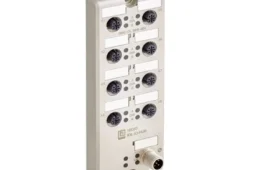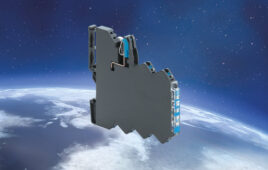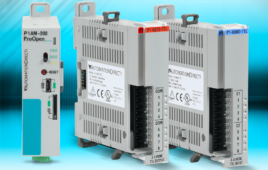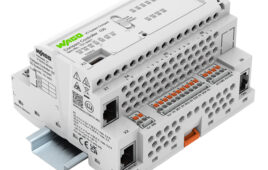By David Schieleit, Product Manager, ActiveTouch, a division of Illinois Tool Works, Buffalo Grove, Ill
The race is on — to develop new cell phones, touch-panel devices, appliances, and other products that are more exciting and more fun to use. One component that is making a difference, and giving new devices an attractive, velvety feel while making them easier to use is touch sensors. Touch sensor developers have made several major improvements and changes in this area recently that can help a wide variety of new products exceed consumer expectations. These devices typically use capacitive sensors to create the ‘touch’ surface. Most capacitive sensors do not need to be actually touched, just bringing something close will trigger them. However, traditional capacitive sensors have some drawbacks. They typically activate only with non-metallic materials, they may not work well with gloves, and they can be falsely triggered by water. Even with these limitations, capacitive sensors work well for many consumer applications.
But because of these few limitations, a new “technology” was developed to make them better. It is called Trapped Acoustic Resonance (TAR). TAR sensors are unique in that they work with metallic substrates. They are called ActiveTouch sensors and can turn a solid steel plate up to 0.5-in. thick into a touch sensitive surface. Furthermore, TAR sensors are insensitive to water and are durable enough to stand the attacks of vandals.

The vibration is tuned to the material and geometry to create a resonance in the material. When the resonant energy is dampened by external contact, the microprocessor identifies that a touch is taking place.
Principles of operation
TAR’s principle of operation is based upon sound wave propagation through a metal substrate. Consider the sound waves from a bell. The sound waves from a bell typically reverberate for some time before they diminish altogether. When you strike the bell again but touch it, the sound dies much sooner because your fingers damp the vibrating energy. For TAR sensors, the same thing happens, but the sound waves’ rate of decay also is detected in the area where an individual touches the surface.
In practice, TAR sensors require a substrate material capable of transmitting shear and torsional mechanical waves at ultrasonic frequencies. This material requires a high “quality factor” known as a high Q. The surface of the high-Q material used for TAR sensors is contoured, and the material traps and localizes ultrasonic energy in resonant cavities.First, a piezoelectric transducer sets a resonator into vibration in the MHz range. The wave motion takes the shape of a cylinder and propagates through the metal. The same transducer that generates the mechanical vibrations (that resonate in the material) also monitors the vibration’s decay. A microprocessor controls the frequency and duration of the electrical input to the transducer. The microprocessor stops driving the transducer for a period, which then lets the resonant, vibrating energy in the substrate feedback and drive the transducer to generate an electrical output signal. This signal defines the characteristic decay of the resonance in the substrate. Next, the microprocessor measures the normal decay rate for the system. Much like the bell, when the surface of the resonant cavity is touched, the finger absorbs the energy in the substrate creating a much faster energy decay rate. Two oscilloscope traces show an untouched state of a switch, and another two show what a touched state looks like. This continuous process of pinging, listening, and evaluating occurs hundreds of times per second.

A resonant cavity will have a defined natural decay curve that is a function of the material, geometry and frequency. The curves on the left represent an untouched resonance decay as captured by an oscilloscope. The curves on the right are ‘touched’ response curves.
When the time to reach a threshold value in the decay curve is shorter than a predetermined value, the microcontroller registers a touch. Controlled by the microprocessor, the touch sensor is programmed to function like a switch – normally open, normally closed, momentary, latching, or time delayed.
The rate at which the vibration decay is reduced to the threshold determines relative pressure sensitivity. The decay rate is a function of the contact material and normal force driving the contact. Some rubber materials dampen the ringing better than a finger, while some fabrics such as a fleece or silk dampen less. Leather work gloves dampen well. For a human-machine interface, the harder a user pushes on the switch surface, the quicker the decay to the threshold. This pressure sensitivity can increase the scroll speed of a menu – the harder the user presses, the faster the menu scrolls.
Water can be a concern for capacitive switches, and it is a good transmission medium for acoustic energy. For example, compression waves (sound) travel well in water. However, the torsional and shear vibration that is created in the ActiveTouch substrate does not couple well with liquids. This greatly reduces the water sensitivity of an ActiveTouch sensor to water. Algorithms employed in the microprocessor filter out any residual effect of water sensitivity.
Benefits beyond a typical switch
As the sensor goes through its “pinging, listening, and evaluating” hundreds of times per second, it can be thought of as having a heartbeat. The microprocessor is constantly monitoring the switch for a decay signal. If that decay signal is not evident, in either a touched or an untouched state, the microprocessor can register an error and communicate it to you. In this manner, the sensor can self-monitor performance and report abnormalities, which aids in trouble shooting or preventive maintenance. The failure of a traditional switch is not known until it is pressed and the desired response does not happen.
Because the shear and torsional energy can be trapped in the resonant cavities, putting multiple switch points into one substrate is possible. With microprocessor advances, a single processor can monitor multiple resonant cavities simultaneously. These two factors make multiple switch points very economical. In addition, by incorporating multiple cavities in close proximity to one another, much like capacitive sensors, a scroll pad or slider can be created – only this time it is in a metal surface.
Traditional piezoelectric switches
While the ActiveTouch technology uses a piezoelectric transducer, the similarities to traditional piezoelectric switches end there. A traditional piezoelectric switch requires a stress to be created in the piezoelectric crystal, creating an electric pulse output. The force an individual applies to the metal surface of a piezoelectric switch creates a stress in both the metal substrate and the piezoelectric crystal. To reduce the force required to generate the stress on the crystal, the metal substrate often becomes quite thin.

When the ‘touch’ response curves crosses predefined thresholds a touch can be registered. By adjusting the threshold level, the switch can be made to be very sensitive, or require a large force to trigger.
This scenario can be problematic. A thin substrate can be susceptible to external shocks and vibrations. These external shocks may couple with the metal substrate to create erroneous switch activations. ActiveTouch is not susceptible to external shocks and vibrations as the ultrasonic energy must be absorbed to trigger a switch. The ultrasonic frequency and narrow frequency band monitored prevent ActiveTouch sensors from being affected by vibrations in most applications.

Specific geometries create “resonant cavities” which trap the ultrasonic vibrating energy in defined regions. The trapping allows multiple sensing points or switches to be created in one metal substrate.
The thin metal substrate required for traditional piezoelectric materials can also influence the spacing of piezoelectric switch points. The switch points must be spaced so that a deflection on one location does not create a false trigger on an adjacent switch point. This can lead to sense points spaced sufficiently far apart that a scroll pad or slider is no longer practical. Resonant cavities in the thicker ActiveTouch substrate eliminate this problem.
Finally, ActiveTouch’s thicker substrate also makes the switches less prone to vandalism. A typical piezoelectric switch’s surface is less than 0.030-in. thick. Keypads using ActiveTouch sensors are over 0.100-in.
Limitations to ActiveTouch
While the ActiveTouch technology has advantages over conventional switches, it does have limitations. They include the following:
• ActiveTouch switches are three-wire sensors programmed to function as a switch. The output can be modified through secondary circuits to meet any application. However, unlike a mechanical switch, switching high current or voltage requires a relay.
• The sensor requires a material with a high Q. This eliminates many plastics such as ABS or polycarbonate. The technology does work well with high talc-filled PPS.
• A material capable of dampening the ultrasonic vibrations is required to trigger the switch. Fingers and leather gloves work well. Thick synthetic fleece mittens require more force. Hard surfaces generally will not trigger a switch at all.
Discuss this on the Engineering Exchange:
Illinois Tool Works
www.itw.com
ITW ActiveTouch
www.itwactivetouch.com
::Design World::
Filed Under: SENSORS, TEST & MEASUREMENT





Tell Us What You Think!